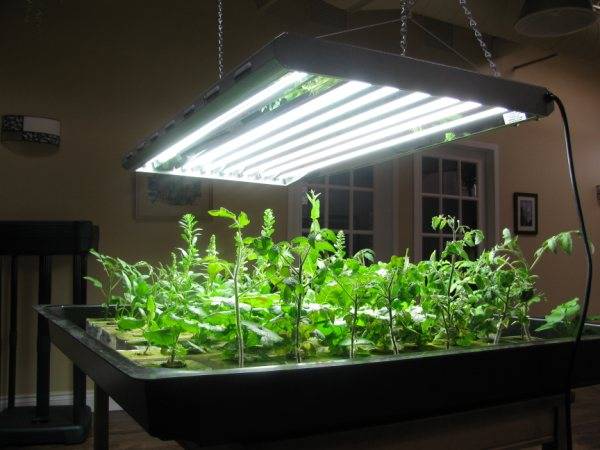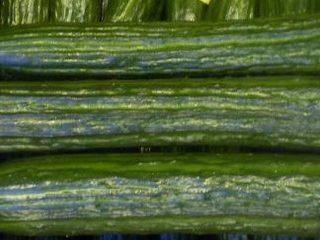Content
Lack of sunlight has a bad effect on the development of seedlings. Without artificial additional lighting, the plants are drawn towards the window glass. The stem becomes thin and curved. Strong darkness creates favorable conditions for the development of pathogenic bacteria. Plantings are affected by “black leg”. It will help to create optimal development conditions lighting for seedlings from lamps.
Need for supplementary lighting
Even when growing planting material in a bright room, additional lighting for seedlings is still required. Sowing seeds in many regions begins in February. At this time of year, daylight hours are still short. Due to lack of natural light, plants begin to starve. With the onset of dusk, the process of photosynthesis decreases. To remedy the situation, vegetable growers organize additional illumination of seedlings at home with their own hands, thereby extending daylight hours.
The benefits of artificial lighting are undeniable:
- increasing daylight hours if early forcing of seedlings is necessary;
- uniform illumination of the entire area prevents stretching and bending of plant stems;
- a well-chosen light spectrum promotes rapid cell development;
- seedlings that receive the required amount of light become more resistant to bad weather conditions and virus damage.
Knowing the benefits of additional lighting, vegetable growers prepare lamps in advance for growing seedlings at home, but they are faced with a new problem. Not all artificial light is good for plants. Regular incandescent lamps will not do any good. The emitted light spectrum is not absorbed by plants. Artificial lighting will be beneficial if it contains red and blue rays.
The red glow is useful for seeds at the initial stage of hatching. The spectrum accelerates the growth of the root system. In the future, this will affect good ovary and rapid ripening of fruits.
Blue light promotes cell division and development. Rapid growth is slowing down. The stem does not elongate, but grows in thickness.
Green, orange and yellow rays reflect off the foliage. These spectra do not play a special role in plant development, but they must be present in artificial lighting.
Options for additional lighting
When choosing a lamp to illuminate seedlings at home, pay attention to two important parameters: low energy consumption and emission of spectra useful for the plant. From the light sources on the market, you can choose the following options:
- Conventional incandescent lamps will not benefit seedlings due to the lack of blue and red spectrum radiation. They consume a lot of electricity. However, the lamp emits a large amount of heat.It can be installed in conjunction with another light source if the room is cool and you need to warm the air around the seedlings.
- The best option is to illuminate the seedlings with fluorescent lamps, which are inferior in performance only to LEDs. Here the cheapness of the product comes first. However, the lamps are low-power, and it is advisable to hang two of them over the seedlings.
- Luminescent Chandelier coasters similarly emit white daylight. However, the lamps cover a small area. It is better to give preference to tubular models.
- Sodium lamps have high light output. Bright yellow light is harmful to vision and does not bring much benefit to seedlings. The lamps are suitable as a temporary light source and preferably in a non-residential room.
- LEDs emit the entire spectrum useful for seedlings. Lamps and lamps are used for illumination, but the most convenient are considered LED strips and rulers. They are conveniently positioned along the entire length shelves rack with seedlings. LEDs are economical, do not emit heat, and have a long service life.
- If you are serious about growing seedlings, then it is better to purchase a phytolamp for illumination. The device consists of a set of red and blue LEDs. Light bulbs of other colors can be added in small quantities. LED phyto-strips are now available for sale. Lighting will be a little expensive, but will pay for itself over time.
The number and power of lamps are selected taking into account the area required to be illuminated.
Arrangement of lighting and space for convenient growing of seedlings
The traditional place for growing seedlings is the windowsill. However, there is not enough space for the drawers, and there is still not enough daylight from the window.You can expand the space and arrange lighting for seedlings at home by resorting to these tricks:
- You can expand the space for seedlings by making a rack. A structure of three shelves is placed on the windowsill. If this is not enough, assemble a stationary rack of five shelves and place it on the floor. It is optimal to choose a place opposite a window so that during the day the plants receive additional natural light. Shelves are assembled from available materials: wooden slats, a steel angle or profile, a PVC sewer pipe with a diameter of 50 mm. The shelves are cut out of durable sheet material.
- A gazebo can be adapted for growing seedlings. Open openings are covered with transparent film. There will be light for the plants in the greenhouse gazebo, but in the evening you still need to turn on artificial lighting. A cheap fan heater is suitable for heating the room.
- To make it happen during production DIY lights for seedlings minimum costs, make a homemade holder for lamps. The design consists of two U-shaped supports with height-adjustable legs and a jumper to which the light source is attached. The holder is more suitable for installation on a windowsill.
- If there is any protruding support above the seedlings in the form of a hook, window loop or handle, attach a pendant light to it. This option is suitable when illuminating seedlings at home on racks. If the lamp is not suitable for hanging, two ends of the chain are attached to its body. The suspension is made adjustable so that you can change the height of the lamp above the seedlings.
- Simple seedling lamp make it yourself from blue and red LEDs.The light bulbs, together with isolation resistors, are soldered together with wires into one circuit, secured to a strip and connected to the power supply. An easier option is to buy an LED strip with an aluminum profile and assemble a lamp from them.
- If additional illumination of a small number of seedlings is required, use a portable shelf. A factory-made floor lamp is suitable, or a 1.5 m high structure can be assembled from slats.
A properly organized place and lighting should provide comfort to the seedlings without creating inconvenience to humans.
The benefits of combining natural and artificial light
The beauty of natural light is that it diffuses its rays over the plants, allowing for better absorption. Any artificial light source emits long, directional rays. If it is not possible to place the seedlings close to the window, you will have to upgrade the lighting. Regardless of the type of lamp used, the lamp is equipped with a matte light diffuser. Short rays will cause less damage to plants.
In a room brightly lit by daylight with large windows, it is advisable to move the seedlings to the windowsill. If it is small, make a rack with three shelves. The combination of natural and artificial lighting will not only save energy, but will also have a beneficial effect on the development of plants.
The light falling from the window brightly illuminates only nearby plantings, while distant plants fall into the shadow. If you don't turn the boxes, the stems begin to stretch towards the window. There are tricks to direct natural light in the right direction and even enhance it. The secret is based on the use of mirror reflectors.Foil, old mirrors or foil insulation - polyethylene foam - are suitable for production.
The bottom line is that the window sill is covered with light-reflecting material, shields are installed on the sides of the window opening and opposite the window behind the boxes with seedlings. It turns out to be a kind of mirrored room, inside of which there are plants. The set falling from the window does not spread throughout the room, but is reflected from the mirror shields, evenly scattered throughout the seedlings. At dusk, artificial lighting is turned on.
LED lamp assembly
It makes sense to assemble a homemade LED lamp if you have unnecessary Christmas tree garlands or pieces of red and blue LED strips lying around at home. Purchasing all the parts specifically is more expensive than purchasing a ready-made phytolamp. To obtain the optimal combination of spectra, a homemade lamp follows the ratio of LEDs: 1 blue light bulb for 2–5 red light bulbs.
If you have LED garlands lying around at home, then the lamp for supplementary illumination of the seedlings is soldered together from separate light bulbs. Any strip or plinth can be used as the basis of the lamp. LEDs are cut off from a non-working garland along with separating resistors. Using a multimeter, check the performance of the parts and also determine the polarity. Working LEDs are soldered in parallel with a wire into one chain. If the lights light up when connected to a DC power supply, the circuit is assembled correctly. All that remains is to secure the luminous chain to the bar with tape or hot glue.
The assembly of the lamp from pieces of LED strips occurs in a similar sequence.On a strip base there are modules consisting of three isolation resistors and diodes. To alternate red and blue light bulbs, you will have to cut the strips into modules and then solder them. It’s easier to attach two LED strips of different luminescence in parallel to the base. It will not be possible to choose the correct ratio of light bulbs, but this will not cause much harm to the seedlings.
The video shows a homemade LED lamp:
When arranging lighting for seedlings with your own hands, you need to take into account the brightness of the lamps and the distance from the seedlings. Plants are differently sensitive to light. Some people are comfortable with bright lighting, while others are comfortable with moderate light. The backlight brightness is adjusted using a dimmer. The regulator is placed in the circuit in front of the lamps. The illumination is adjusted by the height of the lamp. The gap between the light source and the plants is maintained in the range of 10–50 cm. If the lighting is done correctly, the vegetable grower will receive strong seedlings at the time of planting.















